Imagine the smell and taste of food cooked on grills.
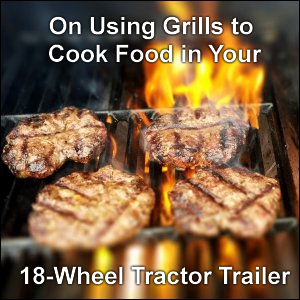 Not only do the units come in many shapes and sizes, but the powering sources include gas, charcoal, stove top, and AC and DC electricity.
Not only do the units come in many shapes and sizes, but the powering sources include gas, charcoal, stove top, and AC and DC electricity.
Why should you leave the taste of grilled food behind when you drive for a living?
Professional truck drivers can enjoy this food cooking option as part of their meal preparation plan, as long as there is no prohibition by their companies or the nature of their loads.
But what else should you know?
The Enlightenment
The first time we even considered the idea of cooking food on a grill on the road was when we cross paths with another husband and wife professional driving team during the time we drove for Swift.
We were in the Pacific Northwest at the time.
The couple said that they had a Hibachi lashed on the catwalk of their tractor.
It would be similar to the one shown here from Amazon.com, with whom we have an affiliate relationship.
It was a revolutionary idea to us. But the questions that came to mind were:
- How much time is required for the charcoal to become gray or ashen (ready to cook food)?
- How does a driver deal with the grease run-off from the food and used charcoal?
- How much time is required for the grill to cool down sufficiently to be moved and transported?
Consider the time, for example, that it would take for this kind of grill to cool.
Gathering the Equipment
Grilling food is pretty easy. You need:
- the cooking device itself;
- an energy source;
- if the unit cooks with an actual fire, a lighter or match;
- appropriate utensils (such as a pancake turner or tongs to turn the food);
- your food; and
- cleaning supplies.
Timing Your Cooking
You need to learn how to time your cooking on a grill, including
- knowing when to put your food on,
- when to turn it, and
- when to remove it.
The size of the cooking surface area — and any associated hot spots — will vary between devices.
Foods cooked on hotter surfaces will cook faster, a situation for which you must compensate.
Never, ever turn your back on — or leave — a grill that is cooking food.
This is both a safety precaution and prevention against burned food.
As with most other cooking devices, grills have limited applications.
For example, they are not intended for boiling water.
For that application, we suggest using a hot pot, electric skillet or microwave oven.
Prohibitions
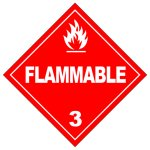 If you drive a truck that hauls flammable cargo -– including but not limited to flammable liquids or compressed gas — then you definitely do not want to use a cooking grill anywhere nearby.
If you drive a truck that hauls flammable cargo -– including but not limited to flammable liquids or compressed gas — then you definitely do not want to use a cooking grill anywhere nearby.
The Federal Motor Carrier Safety Regulations (FMCSR), Part 397:
Transportation of hazardous materials; driving and parking rules, Subpart A — General §397.13 Smoking, require a driver to be at least 25 feet from his/her truck in order to smoke.
It is best not to court danger by having with you the elements with which to start a fire when you haul flammable loads.
Advantage of Gas Over Charcoal
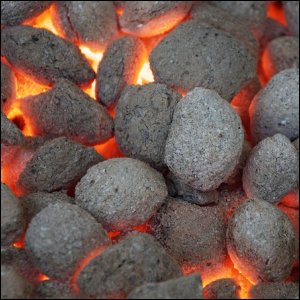 Two of the most popular energy sources for powering these pieces of cooking equipment are gas and charcoal.
Two of the most popular energy sources for powering these pieces of cooking equipment are gas and charcoal.
Using gas (such as propane or butane) relieves you of the wait time associated with heating up and cooling down charcoal.
However, you must still wait for the unit to cool down and you must still deal with the grease run-off.
Besides less heat up and cool down time, gas grills can be adjusted for heat by the control knob.
Charcoal cannot, in our experience, be coaxed to cook hotter or faster, although the addition of lighter fluid can cause the flames to shoot higher for a short period of time.
(Great caution should always be exercised in adding lighter fluid to a fire in progress.)
Precautions in Transporting Compressed Gas or Lighter Fluid
If you prefer to use compressed gas as an energy source, be aware that you will need to properly store and transport the cylinder or canister.
You don’t want a gas leak in your truck.
Also, you don’t want to run the risk of causing an explosion (which is a special concern for drivers who smoke).
Follow all instructions regarding the maximum temperature of the cylinder or canister storage area.
The same care that is given to the gas cylinders or canisters should be taken regarding lighter fluid.
Setting Up
Since your grill must be hot enough to cook food, you must bear in mind what will be under and around it.
Where and how will you set it up?
If it is a table-top type unit, will you set it up on
- the floor of your truck,
- the ground outside your truck, or
- a table or other platform?
Beware of operating such a device around plastic that can melt.
You don’t want an awkward situation in which the heat forces you to have to move it.
You’ll want to plan ahead.
All That Grease!
We like grilling hamburgers at home.
The type of raw hamburger meat that we typically buy is usually either 73% or 80% lean, meaning that the remainder is fat.
When the meat is cooked this way, the fat turns to grease and runs down through the grate into the bottom.
Depending on your unit’s design, the grease may run into small crevices, making clean up a real chore.
You will want to make sure that you properly dispose of the grease and thoroughly clean your cooking apparatus so that it will be ready for the next time you want to use it.
If you dump hot grease down a standard sink, make sure to chase it with plenty of hot soapy water.
Do not under any circumstances dispose of hot grease in a plastic container that can melt. This includes your portable toilet.
Disposal of Waste
Besides disposing of the grease run-off, if you use charcoal, you will need to arrange for the disposal of the used charcoal.
You cannot dump grease and used charcoal just anywhere.
The used charcoal must be thoroughly extinguished and totally cool so that it has no chance whatsoever of starting a fire.
You may have heard or read stories of people who carelessly lit a match or left a fire not properly extinguished that led to the burning down of untold acres of forest land.
Your clean up is not complete unless waste disposal matters are completely taken care of.
Cleaning Supplies
You will want to use a dish washing detergent that can cut grease effectively.
(We like the original blue variety of Dawn.)
You will need a dishcloth, perhaps a scrubber and maybe even a wire brush.
Of course, you will need to have a supply of water, too.
If you have only the water you can carry with you in your truck for cleaning, you might want to reconsider grilling your food.
Space and Storage Limitations
A lot of grills on the market today are way too big to take in an 18-wheel tractor trailer, perhaps like the one shown here.
Consider your truck’s space limitations before you invest in one specifically to use on the road.
Where will you store it:
- under the bunk,
- in front of the passenger seat, or
- lashed down on the catwalk?
If you intend to lash down your grill on the catwalk behind your truck’s cab, be aware that
- you will mostly likely need one or more bungee cords (or rubber tie downs) to secure it,
- it is susceptible to being stolen, and
- its presence may limit your truck’s ability to turn.
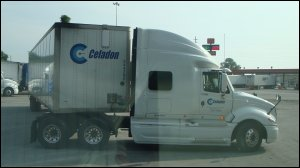
Vicki took the photo shown here through the windshield of Mike’s truck specifically to show that there is no room whatsoever to store a grill on this truck’s catwalk.
Some units are intended to be folded for easier storage.
You might want to measure the storage areas in your truck and compare those to the exterior dimensions of the units you’re considering before investing in one.
Electric Unit
There are grills that can be plugged into a conventional AC electrical outlet, like the one shown here.
We have never used one and wonder how well they work and how easy they are to clean up.
If you intend to use one of these, you will need, of course, to make sure that
- the unit you select pulls no more power than your inverter is able to provide,
- the length of the cord (or extension by power strip or surge protector) is sufficient to allow you to set up the unit without problems, and
- you have adequate ventilation.
One idea for powering such a unit without being limited to inverter power is to power it outside your truck from the electrical outlet of an IdleAir unit.
Some electric grills have a combination grill and griddle in one.
12-Volt Unit
There are DC-powered 12-volt grills that you can use in your truck.
Naturally, the amount of power to operate such a unit is limited by what you can draw from your 12-volt cigarette lighter.
You still have to deal with the grease run-off from your food.
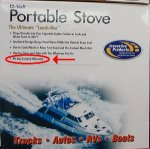
And just as with the electric unit used in your truck, you will need adequate ventilation.
Before buying any 12-volt appliance, check out the warranty.
It is most unfortunate that some 12-volt cooking devices sold in truck stops have only a 90-day limited warranty.
(See the photo of the box of one such product here.)
If you were to compare the warranties of some 12-volt appliances with the warranties of similar AC-powered units, you may find the latter to be a better deal in the long run.
Stove-Top Units
We have a stove-top or “indoor” grill that requires energy from outside itself to operate.
It consists of
- a drip pan (the metal ring with a trough to hold water) that sits directly on the eye of a stove, and
- a grill (the cooking surface, being a slightly convex-shaped, coated metal disk with holes through which the grease run-off drains into the trough) that rests upon the drip pan.
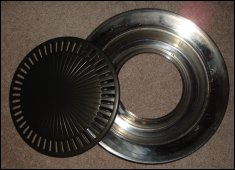
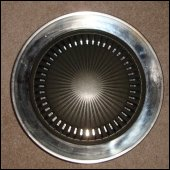
The cooking surface heats up both through the ring and from the eye beneath it (even though it does not touch the eye directly).
As the food is cooked, the grease runs down the slope of the metal disk into the trough in the ring.
It is simple to use and fairly easy to clean.
One of the advantages of using this type of grill is that you don’t have to invest in gas or charcoal to operate it.
However, its use presupposes that you have a stove or hot plate or burner of some kind (perhaps even a camp stove) working below it.
Instructions for Indoor BBQ Grill
- For Electric Stove: Firmly place drip pan onto stove burner.
For Gas Stove: Firmly place drip pan onto stove grate.
Removal of grate may be necessary for firm placement.- Fill drip pan with ¼ cup of water. Refill as necessary. Do not allow drip pan to become empty.
- Cover drip pan with grill surface.
- Preheat grill surface. Increase heat gradually until preferable temperature is reached. Temperature may vary according to type of stove.
- Begin cooking.
Caution: Proper ventilation is recommended. Allow grill and drip pan to cool before removing.
Microwave Units
We have a microwave browning device that consists of a solid base containing a non-stick surface and a lid that fits on top.
It is to be used in a microwave oven only.
These units are not as popular as they used to be.
Cooking Surface Area
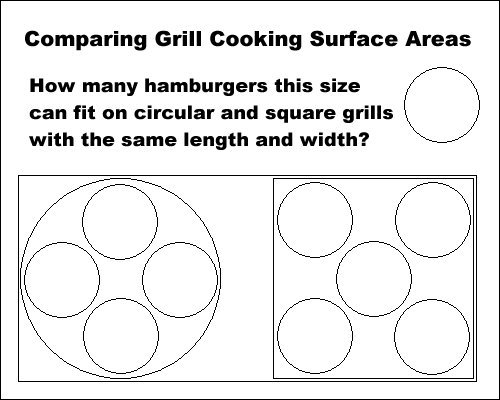 In your consideration of a grill to use in your truck, think about the cooking surface area and the amount of food that you will be able to cook at one time — that is, its “efficiency.”
In your consideration of a grill to use in your truck, think about the cooking surface area and the amount of food that you will be able to cook at one time — that is, its “efficiency.”
As you can see in this illustration, circular and square surface areas that are the same length and width can accommodate different numbers of hamburgers.
The circular surface can hold four while the square area can handle five.
If it is your goal to be efficient in your cooking, processing more food in less time, bear this in mind.
Our Experience
We have never cooked food on a grill while on the road.
And we for sure would never cook food on the one that we use at home because of the chore of cleaning up the grease run-off.
Your experience may be different.
We that if you want this kind of taste, you let your home support team cook it at home and then you heat it up in your truck by another method.
![]() Money saving tip: In general, you can save money by cooking your own food instead of eating out in restaurants.
Money saving tip: In general, you can save money by cooking your own food instead of eating out in restaurants.
If you have a grill and are considering using it on the road, you will have to weigh the cost of your time spent on
- setting it up,
- using it or cooking on it, and
- cleaning it up.
There are cooking methods that take far less time.
If you would still like to use a grill, you can save money by looking for items on sale, both the unit itself and the energy source.
Many people cook this way during the summer, so you might be able to find good discounts near or at the end of the season.
Also, you might be able to find a good used unit. Look in the want ads, classified ads or even online auctions.
If you’re considering a used unit, make sure that it has all of the needed components before you buy it.
Some questions you might ask are:
- Does it have all of the grates/racks?
- If it runs on gas, does it have the connector where the gas cylinder or canister attaches?
- Are there any cracks or other known defects?
Return from Using Grills to Cook Food in Your 18-Wheel Tractor Trailer to our Meal Preparation page or our Truck Drivers Money Saving Tips home page.







